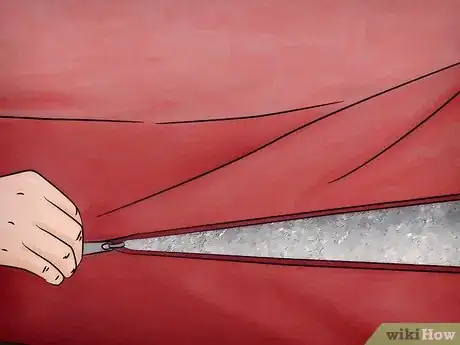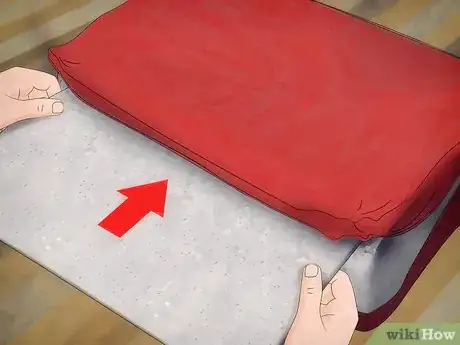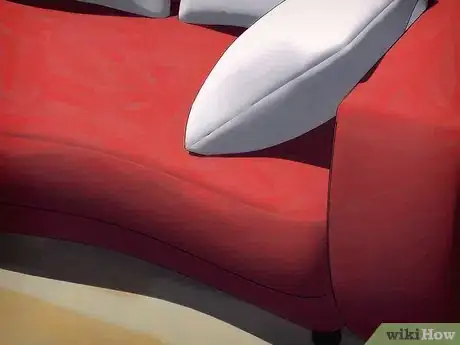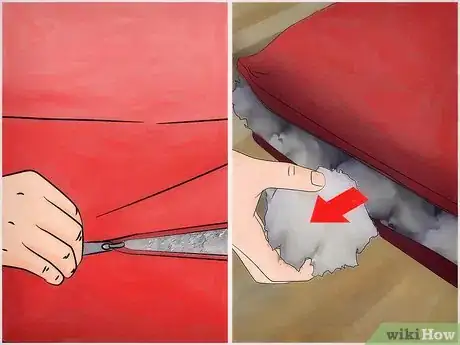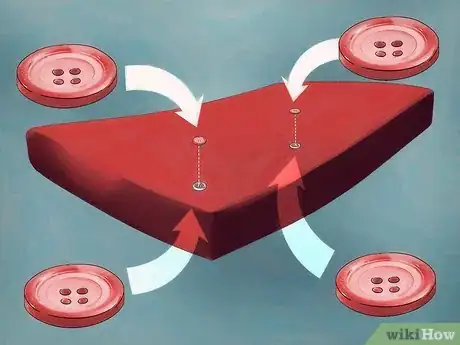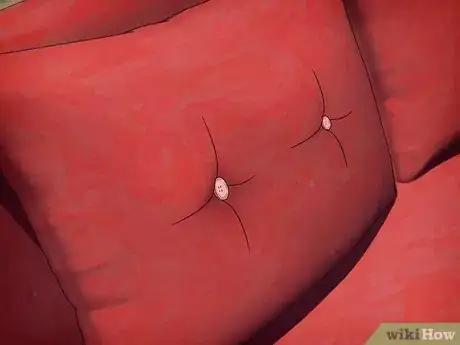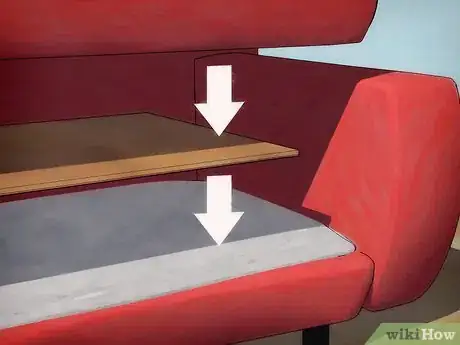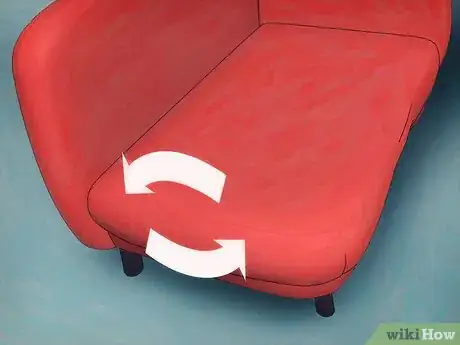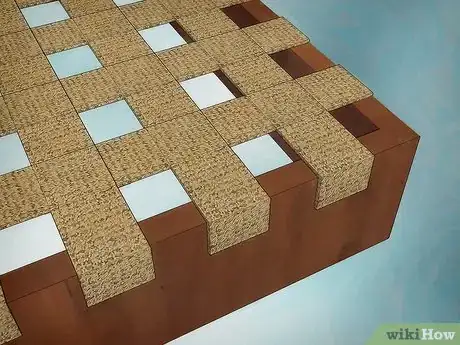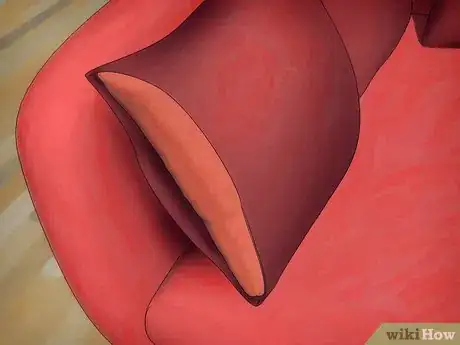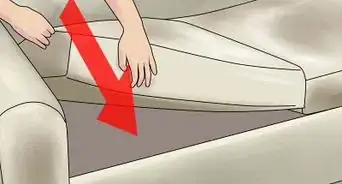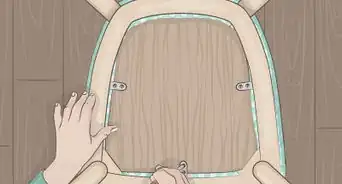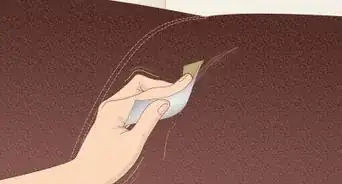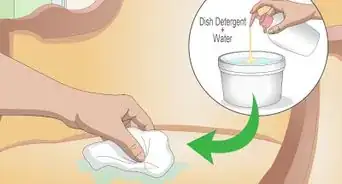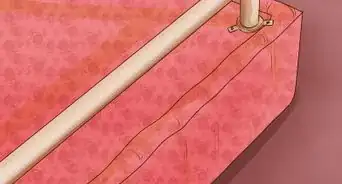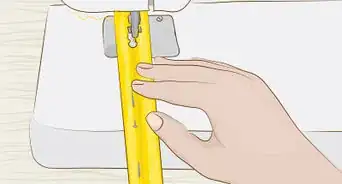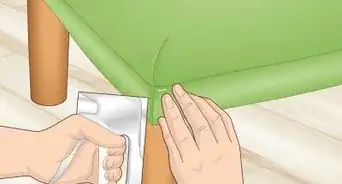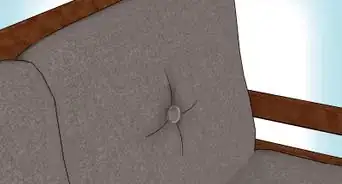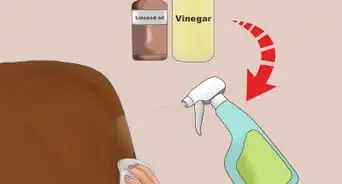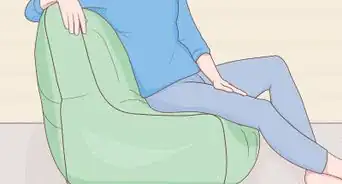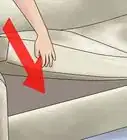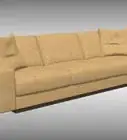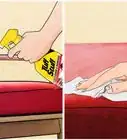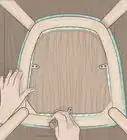This article was co-authored by Katherine Tlapa. Katherine Tlapa is an interior designer, currently working as a Design Specialist for Modsy, a design service based in San Francisco. She also runs her own DIY Home Design blog, My Eclectic Grace. She received her BFA in Interior Architecture from Ohio University in 2016.
This article has been viewed 385,189 times.
Sofas that are well-worn and used often may develop sagginess in their cushions. Sagging sofa cushions are uncomfortable and unsightly. However, there are a few different ways you can fix this problem using simple home DIY techniques.
Steps
Re-Stuffing the Cushions
-
1Unzip your cushions. Most sofa cushions, even cushions that are attached to the frame of the couch, have zippers that can be unzipped. Inside, you will see a couch cushion.
- If your sofa cushions have no zippers, you could open the pillow with a thread cutter.
-
2Add more stuffing your couch cushions. You should use either quilt batting or polyester fiberfill. Both polyester fiberfill and quilt batting can be purchased at a craft store or at a large store that sells home goods, like Walmart. Insert more foam, spreading it around to make it smooth and even. You can put it around the current couch cushion but inside the pillowcase. If it is badly worn, you may need to replace the foam.
- If your cushions are filled with loose stuffing, stuff them with polyester fiberfill. You do not need to take any of the current stuffing out of the pillows. Use your hand to distribute it evenly.
- If they are more like pillows, you can wrap them with quilt batting. Take the pillow out of the pillowcase and wrap it in the quilt batting. You can use an adhesive spray (purchased at a craft store) to secure the quilt batting to the current pillow.
- If you have just a cushion inside the pillowcase, you can still add loose stuffing. Spread the polyester fiberfill evenly around the pillow to make sure that the pillow is not lumpy. When you stuff the cushions, use your hand to spread the stuffing evenly around.
Advertisement -
3Zip them up again. Put pillows back in the cushion covers and zip. Give them a good fluff and put them back on the couch. They should be plumper, more aesthetically pleasing, and more comfortable.[1]
- If you opened your pillows with a thread cutter, you should sew the pillow back together again at the end of the stuffing process.
Cinching Cushions with Buttons
-
1Unzip the cushion. If the cushion does not unzip, open it with a thread cutter. Take out all of the stuffing inside the pillow and set it aside.
-
2Find a needle, thread, and four buttons. Sew the four buttons onto the sofa cushions, two on the front and two on the back. Use the same piece of thread to sew on all four buttons, so that all four buttons are cinched by the thread.
- You can also use more or fewer buttons depending on the size of the pillow. A throw pillow might require just two buttons, but a large sofa cushion might require more.
- Retrace the thread several times over. You want the cinching to be strong between the buttons so that it lasts a long time.[2]
-
3Refill the pillows. Feel free to also add more polyester fiberfill or quilt matting if you desire. Make sure that the padding is evenly and thoroughly distributed inside the cushion.
-
4Zip the cushion. Sew it back together, if you used a thread cutter to open the cushion. Fluff the pillow and put it back on the sofa.
Fixing Structural Issues
-
1Support your couch cushions. You can buy “sofa savers” for sofas online or at home goods stores like Bed, Bath & Beyond. Put these supports underneath your couch cushions to give them more support and firmness.[3]
-
2Cut a piece of plywood to fit underneath the sofa cushions. Measure the space underneath the sofa cushions and cut a piece of plywood to those dimensions. Place it underneath the cushions. You will feel more support underneath the cushions, and the couch should sag less.[4]
-
3Repair the springs. Flip the couch over and expose the springs underneath the couch. To repair the springs of your sofa, you will need to wear glasses and use a pair of pliers. If you see any springs that are bent out of place (i.e., they look different from the rest of the springs), bend them back with the pliers gently.[5]
Finding Other Potential Solutions
-
1Flip over your cushions often. Flip over your sofa cushions frequently to prevent the stuffing being worn down repeatedly in one place.[6] Move the cushions around on the sofa and flip them over once a week, or every time you clean the house.
-
2Repair your jute webbing. The jute webbing of your couch is the bottom layer of upholstery. The springs press down on this layer and can make it worn and saggy with frequent use. If your couch is sagging because the bottom layer of upholstery is worn, you should bring your couch to an upholstery expert to repair it. Luckily, this problem is easy to fix for an upholsterer.[7]
-
3Cover the pillows with a blanket or a piece of fabric. If you don't have the time or resources for any other solution, your sofa cushions will look more full and plump if you cover them with a thick blanket or piece of fabric. You can tuck it into the sides and back of the couch, too.[8]
Expert Q&A
-
QuestionHow do you fix bad couch cushions?
 Katherine TlapaKatherine Tlapa is an interior designer, currently working as a Design Specialist for Modsy, a design service based in San Francisco. She also runs her own DIY Home Design blog, My Eclectic Grace. She received her BFA in Interior Architecture from Ohio University in 2016.
Katherine TlapaKatherine Tlapa is an interior designer, currently working as a Design Specialist for Modsy, a design service based in San Francisco. She also runs her own DIY Home Design blog, My Eclectic Grace. She received her BFA in Interior Architecture from Ohio University in 2016.
Interior Designer If your couch cushions are foam, you can buy new foam core and cut it to replace the old foam. You’ll have to be able to open the cushion to do this. If your cushions are filled with down, cotton, or plastic stuffing, you can simply add more stuffing to even out where the cushion is sagging.
If your couch cushions are foam, you can buy new foam core and cut it to replace the old foam. You’ll have to be able to open the cushion to do this. If your cushions are filled with down, cotton, or plastic stuffing, you can simply add more stuffing to even out where the cushion is sagging. -
QuestionHow do I boost the springs of a sofa?
 Community AnswerWorking with sofa springs can be dangerous because they use so much tension, so you should get your sofa repaired by a professional. You could try putting a piece of plywood underneath the sofa springs, though, to give them an extra boost.
Community AnswerWorking with sofa springs can be dangerous because they use so much tension, so you should get your sofa repaired by a professional. You could try putting a piece of plywood underneath the sofa springs, though, to give them an extra boost. -
QuestionHow do I fix saggy tops of back sofa cushions?
 Community AnswerGet a box of polyfill, and stuff the backs till plump. You might have to create an opening, so make sure it can be sewn back together with ease and can be covered or well hidden.
Community AnswerGet a box of polyfill, and stuff the backs till plump. You might have to create an opening, so make sure it can be sewn back together with ease and can be covered or well hidden.
Warnings
- Be careful if you choose to work with the springs of the couch. They can be sharp and dangerous.⧼thumbs_response⧽
- Be careful of overstuffing your cushions. You could rip the seams or break the zipper.⧼thumbs_response⧽
References
- ↑ http://livingrichonless.com/how-to-make-an-old-couch-new-again-for-10/
- ↑ http://www.care2.com/greenliving/try-this-1-diy-fix-for-sagging-couch-cushions.html
- ↑ http://www.bedbathandbeyond.com/store/product/furniture-fix-sofa-support/1018158701
- ↑ http://www.yellowpages.ca/tips/how-to-repair-a-sagging-sofa/
- ↑ http://www.limsupholstery.com/how-to-fix-a-sagging-couch/
- ↑ http://www.huffingtonpost.com/entry/fix-a-saggy-couch-butt-dent_us_561fb18fe4b0c5a1ce622b59
- ↑ http://www.huffingtonpost.com/entry/fix-a-saggy-couch-butt-dent_us_561fb18fe4b0c5a1ce622b59
- ↑ http://www.huffingtonpost.com/entry/fix-a-saggy-couch-butt-dent_us_561fb18fe4b0c5a1ce622b59
About This Article
If your couch cushions are sagging, adding new stuffing can be a quick and easy fix. Unzip the cushions and add some extra quilt batting or polyester fiberfill, then spread the filling out so that the stuffing is nice and even. If your cushions have foam or pillows inside, you can still pad them out by wrapping some extra filling around the inner cushion. When you’re done, zip the cushions up again and gently fluff them before putting them back on the couch. Sometimes couch cushions sag because the support structure underneath them starts to wear out. If you think this is the problem, try putting a “sofa saver” or a piece of plywood under the cushions to help hold them up. You can also replace the springs or the jute webbing under the cushions if those are starting to sag or break down. To learn how to fix structural issues that can make your sofa sag, read on!
